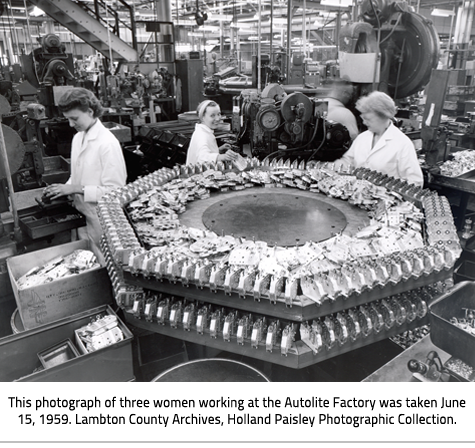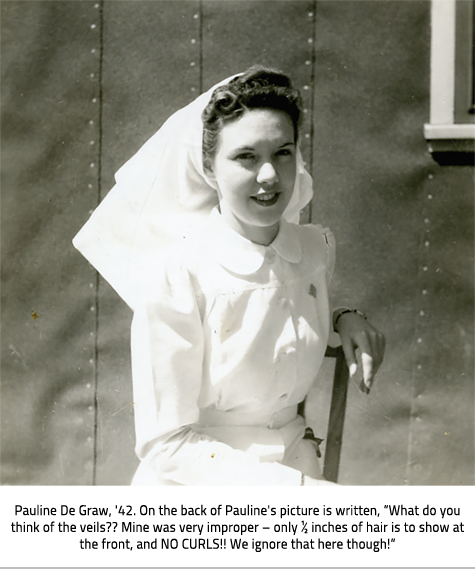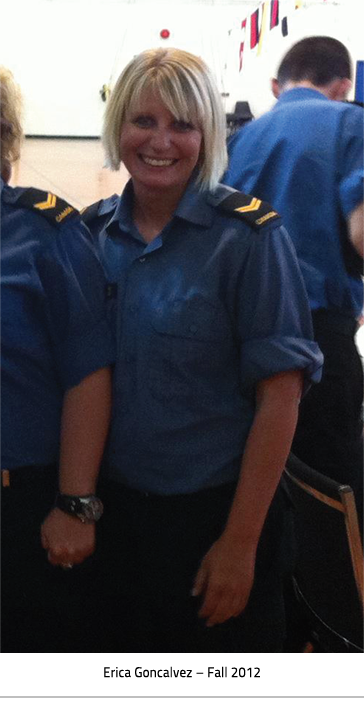Women in the Military
The role of women in the military has changed in the last 50 years.
Woman first became involved in the Canadian Forces as nurses in 1885. They continued to be engaged as fundraisers during World War I and World War II by sending money and care packages to soldiers.
During both World Wars, women worked in factories to power the industrial war effort. Women contributing to the military effort in factories were not active participants in the conflict but were still crucial for victory.
It was during World War II that the first women served full-time in the military in non-nursing roles, ranging from clerks, cooks and drivers to mechanics and parachute riggers. More than 45,000 Canadian women served in this way during World War II.
During the 1970s rules were changed to support the inclusion of women in the military. In 2013, women made up 5% of the Canadian Forces.
The Government of Canada's Canadian Armed Forces website includes an overview of Women in the Canadian Armed Forces.
Fundraising at Home
Although barred from active military service, women were able to contribute to the war eff ort by fundraising and sending care packages to soldiers.
One local example of a fundraising group is the Inwood Red Cross Society. The Red Cross was established by an act of Parliament in 1909. During Louis Riel's 1885 Northwest Rebellion Dr. George Ryerson designed a Red Cross flag to identify the wagon he used to transport wounded soldiers. He later founded the British Red Cross overseas, which became the Canadian Red Cross.
The Inwood Red Cross was established in 1940. On June 1st the group put out a call for “wool blankets so urgently needed.” Not wasting any time, by June 3rd members had shipped from Inwood “four pair new blankets and four slightly used blankets.”
Not exclusively a female fundraising eff ort, the Inwood Red Cross Society demonstrated how men and women worked together to provide for Canada's armed forces during WWII. Women held many important roles in the society including secretary, treasurer, sewing convenor, knitting convenor, quilting convenor, and social convenor.
The Industrial War Effort
 Women not in active military service still contributed to the war eff ort in World War I and World War II through manufacturing on the home front.
Women not in active military service still contributed to the war eff ort in World War I and World War II through manufacturing on the home front.
WWI and WWII were truly global conflicts that ushered in an era of total war. This new warfare mobilized entire populations and required non-combat citizens at home to contribute to
the war effort.
With so many men recruited into service, women stepped into manufacturing jobs that they would have been barred from in earlier years. Also, the sheer number of manufacturers that
were necessary to spur the war effort required extra hands in the factories.
Women in Lambton County and across Canada entered the workforce in new roles. The Sarnia Canadian Observer reported in a cover story on June 19, 1919 that “During the war when factories were running at top speed, in the neighborhood of 5,000 men and women were employed. These were secured from Sarnia, Port Huron, Mich., and many other towns and country villages within twenty-five miles of Sarnia.”
Nurses at War
 Nursing offered the first opportunity for women to become actively involved in combat situations in Canada's armed forces.
Nursing offered the first opportunity for women to become actively involved in combat situations in Canada's armed forces.
During Louis Riel's 885 Northwest Rebellion women served as nurses in the Canadian military history for the first time. By World War I, there were more than 3,000 nurses in the Canadian Army Medical Corps, including 2,504 overseas. They were nicknamed “bluebirds” because of their blue uniforms and white veils. These women were all trained nurses between the ages of 21 and 38, with 24 as the average age.
Inez (Empey) Williams graduated from the Sarnia General Hospital nursing school in 1941. She served overseas during World War II. Here are a collection of her memories published in a souvenir booklet put together by the Sarnia General Hospital Nursing Alumni Association and released in 1995. She recalls conditions working in England as well as counties on the continent including France, Belgium, Holland and Germany:
- “In a hospital unit in England nursing was quite similar to nursing in a civilian hospital. There were approximately 85 nurses, 45 doctors, and 350 other ranks, which included laboratory technicians, store-room help, dispensary help, orderlies, etc., for a 1,200 bed hospital. Plenty of drugs, linen, water and cleaning material were available at all times.”
- “France, Belgium, Holland and Germany presented many problems for nurses. Food was very poor. The first night we arrived in France we were given a piece of corned beef and two biscuits. This was our first food since noon that day and was to last until the next morning… dysentery was common among the staff.”
- “In the field the entire unit was placed under canvas. The wards were made in the shape of an E, each ward with an average of 75 beds… Patients were classified according to the severity of their wounds to compile a priority list for surgery… Dressings were done in order on admission by the doctor in charge. After surgery, and after the removal of the first dressing, the nurse usually did the necessary treatments.”
- “Evacuation day from a ward was a headache to all concerned. An evacuation priority list was compiled by the doctor in charge. All wounds were re-dressed if necessary. Evacuation tags were placed on each patient. The field card (the patient's chart) and the X-ray film were sent with each patient. Patients were assigned to a particular ambulance and care had to be taken to see that these assignments were carried out correctly.”
- “Operating room techniques were as sterile as possible under the circumstances. Little could be done to keep instruments boiled at all times. There were five tables operating continually and surgery was carried on until all patients had received attention. Very little sterile linen was available. A central table held all instruments, towels and sutures and was a great help. This was cleaned every eight hours… Nurses and doctors worked in khaki with white rubber aprons. They were allowed one pair of rubber gloves for each eight-hour shift, unless a glove was torn. Gloves and instruments were soaked in antiseptic solution between operations.”
- “Hours of duty varied from ten to fourteen, depending entirely on the ward assignment. If your ward was not busy extra time off dusty was allowed. Each nurse was allowed a forty-eight hour pass every three months.”
- “In nursing overseas there is an atmosphere of friendliness and co-operation unknown to a great many civilians. The patients respected the Canadian nurse on the battlefield. These nurses worked hard and long hours, and their work was praised by all soldiers wounded in France, Belgium, Holland, Germany and Italy.”
Learn more about Early Nurses in Training.
The Sarnia General Hospital School of Nursing had ten graduates who served overseas:
|
World War I |
|
Amelia Kenny (1901) |
|
World War II |
|
Pearl Bloomfield (1941) Pauline De Graw (1942) Inez Empey (1941) Annie Frayne (1933) Greta Hothersal (1933) Daisy M. King (1940) Geraldine Lake (1940) Isobel McLean (1936) Margaret Pateman (1941) |
Life in the Canadian Forces
 In 2013, the Canadian Forces were composed of 5% women, with a goal of increasing that percentage to 25%.
In 2013, the Canadian Forces were composed of 5% women, with a goal of increasing that percentage to 25%.
That vision is being achieved through re-education regarding what life is like in the Canadian Forces for women. Arkona resident Erica Goncalves provides a local perspective on women in the military. She sees the number of women in the Canadian Forces increasing. “Women can be in the infantry or they can do a desk job. Women can work anywhere, although there are fewer women on submarines, which have very diff cult living quarters.”
Erica enlisted in the Navy in May, 2009. She works as a training coordinator in London and her trade is a boatswain. Erica has served on ships including Her Majesty's Canadian Ships Whitehorse, Protector and Nanaimo. “I'm comfortable in the military… [it] offers independence and a chance to make a life for myself.”
With two young boys, Erica finds being away from home while on sailing contracts the most challenging aspect of her career. “When you're sailing you only get a 10 minute phone card per week. You also have time changes to contend with when you're calling home.”
The most rewarding thing about Erica's military career is “coming away with the bonds and relationships… you really get to know someone's character through hard times and good times. You see people under pressure and learn who they really are.”


 Subscribe to this page
Subscribe to this page